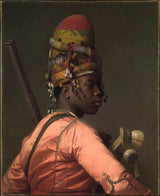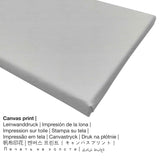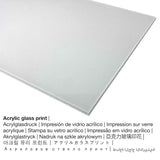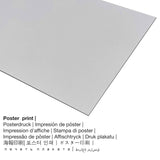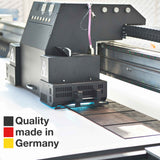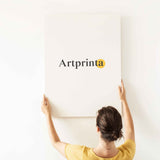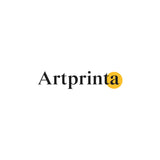Jean-Léon Gérôme, 1868 - Bashi-Bazouk - ọmarịcha nka
Ụtụ gụnyere. Mbupu gbakọrọ na ndenye ọpụpụ.
Nkọwapụta edemede
Ihe nka nka Bashi-Bazouk onye na-ese ihe n'ezie sere ya Jean-Léon Gérôme in 1868. The 150 artpiece dị afọ tụrụ nha: 31 3/4 x 26 inch (80,6 x 66 cm) na e mere ya na Usoro of mmanụ na kwaaji. Today, the work of art is included in the digital collection of Museumlọ ihe ngosi nka nke Obodo in New York City, New York, Njikota Obodo Amerika. Site n'ikike nke: Ụlọ ihe ngosi nka nke Metropolitan, New York, Onyinye nke Oriakụ Charles Wrightsman, 2008 (ọha na eze). Ihe kredit nke artpiece bụ: Onyinye nke Oriakụ Charles Wrightsman, 2008. Besides, the alignment is portrait with a ratio of 1: 1.2, nke pụtara na ogologo bụ 20% mkpụmkpụ karịa obosara. The painter Jean-Léon Gérôme was a European artist from France, whose art style can be attributed mainly to Realism. The French painter lived for a total of 80 years and was born in 1824 and deceased in the year 1904.
What does the website of the The Metropolitan Museum of Art write about this 19th century artwork made by Jean-Léon Gérôme? (© - nke Ụlọ ihe ngosi nka nke Obodo ukwu - www.metmuseum.org)
This arresting picture was made after Gérôme returned to Paris from a twelve-week journey to the Near East in early 1868. He was at the height of his career when he dressed a model in his studio with textiles he had acquired during the expedition. The artist’s Turkish title for this picture—which translates as "headless"—evokes the unpaid irregular soldiers who fought ferociously for plunder under Ottoman leadership, although it is difficult to imagine this man charging into battle wearing such an exquisite silk tunic. Gérôme’s virtuosic treatment of textures provides a sumptuous counterpoint to the figure’s dignified bearing.
Data ndabere na artpiece
| Aha ọrụ nka: | "Bashi-Bazouk" |
| Nhazi nka: | sere |
| Okwu mkpokọta: | nkà nke oge a |
| Narị afọ nka: | 19th narị afọ |
| Emepụtara na: | 1868 |
| Afọ nka: | 150 afọ |
| Ọkara nke ihe osise izizi: | mmanụ na kwaaji |
| Akụkụ izizi nka: | 31 3/4 x 26 inch (80,6 x 66 cm) |
| Ụlọ ihe ngosi nka / mkpokọta: | Museumlọ ihe ngosi nka nke Obodo |
| Ebe ngosi nka: | New York City, New York, Njikota Obodo Amerika |
| Ibe weebụ: | Museumlọ ihe ngosi nka nke Obodo |
| Akwụkwọ ikike nka: | ngalaba ọha |
| Site n'aka: | Ụlọ ihe ngosi nka nke Metropolitan, New York, Onyinye nke Oriakụ Charles Wrightsman, 2008 |
| kreditline ọrụ nka: | Onyinye nke Oriakụ Charles Wrightsman, 2008 |
Nchịkọta ihe nkiri
| Aha onye nka: | Jean-Léon Gérôme |
| okike nke onye nka: | nwoke |
| Nationality: | French |
| Ọrụ onye na-ese ihe: | onye na-ese ihe |
| Country: | France |
| nhazi ọkwa: | omenkà nke oge a |
| Ụdị nka: | Ihe ngosi |
| Nwụrụ anwụ: | 80 afọ |
| Afọ ọmụmụ: | 1824 |
| Afọ ọnwụ: | 1904 |
Nweta ụdị ihe onwunwe gị
The product dropdown menu gives you the opportunity to select the size and material of your choice. Thus, we allow you to choose among the following options:
- Mbipụta kanvas: The printed canvas, not to be confused with a canvas painting, is a digital image printed directly on cotton canvas. Canvas Prints have the advantage of being relatively low in weight, meaning that it is easy to hang up your Canvas print without the help of extra wall-mounts. Canvas prints are suitable for any type of wall.
- Mpempe akwụkwọ mmado ebipụtara na akwa akwa: Our poster print is a printed canvas paper with a granular surface texture. Please bear in mind, that depending on the absolute size of the poster we add a white margin of around 2 - 6cm round about the painting to facilitate the framing with your custom frame.
- Mbipụta aluminom (aluminium dibbond): An Aluminium Dibond print is a print with a true depth - for a modern look and non-reflective surface. A direct Direct Print on Aluminum Dibond is the best introduction to fine art replicas on aluminum.
- Mbipụta enyo acrylic: An acrylic glass print, which is often referred to as a plexiglass print, transforms an original artwork into home decoration. Your artwork is being custom-made with the help of state-of-the-art UV direct printing machines. This creates impressive and vivid print colors. The major upside of an acrylic glass print is that contrasts and smaller painting details become more exposed with the help of the very fine tonal gradation. Our plexiglass protects your custom art replica against sunlight and heat for up to six decades.
Nkọwa edemede
| Nkewa ngwaahịa: | nka nka |
| Usoro mmeputakwa: | dijitalụ mmeputakwa |
| Production usoro: | Mbipụta UV ozugbo (mbipụta dijitalụ) |
| Ihe ngosi: | arụpụtara na Germany |
| Stockdị ngwaahịa: | mmepụta ihe na-achọ |
| Ngwaahịa were: | ime ụlọ, ihe ndozi ụlọ |
| Nhazi onyonyo: | nhazi ihe osise |
| Ụdị anya: | 1: 1.2 |
| Akụkụ onyonyo pụtara: | ogologo bụ 20% mkpụmkpụ karịa obosara |
| Nhọrọ akụrụngwa: | ígwè ebipụta (aluminium dibond), acrylic glass print (nwere ezigbo mkpuchi iko), mbipụta akwa akwa, mbipụta akwụkwọ mmado (akwụkwọ kwaaji) |
| Nha n'arọwa n'elu ihe ndọtị (mbipụta akwa akwa): | 50x60cm - 20x24", 100x120cm - 39x47", 150x180cm - 59x71" |
| Mbipụta iko acrylic (nwere ezigbo mkpuchi iko) nhọrọ nha: | 50x60cm - 20x24", 100x120cm - 39x47", 150x180cm - 59x71" |
| Ụdị akwụkwọ mmado (akwụkwọ kwaaji) dị iche iche: | 50x60cm - 20x24", 100x120cm - 39x47" |
| Nhọrọ ebipụta aluminom: | 50x60cm - 20x24", 100x120cm - 39x47" |
| Igwe onyonyo: | ngwaahịa anaghị emebi emebi |
Ederede iwu dị mkpa: We do our utmost in order to describe our art products as closely as we can and to display them visually in our shop. Although, the colors of the print products and the imprint may diverge somehwat from the presentation on your screen. Depending on your screen settings and the condition of the surface, not all colors are printed as realisitcally as the digital version shown here. Given that all our art prints are processed and printed by hand, there might also be minor discrepancies in the motif's exact position and the size.
© Nwebiisinka nke | Artprinta.com (Artprinta)

